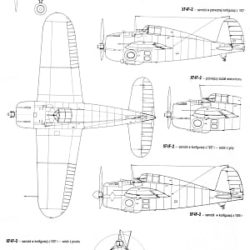Grumman F4F Wildcat History
Grumman’s original proposals, which won a 1936 US Navy development contract, were for a biplane carrier fighter based on its earlier successful biplane types. This design, the XF4F-1, was then shelved in favour of a monoplane fighter whose prototype, the XF4F-2, was flown on 2 September 1937 powered by a 1,050 hp R-1830-66 Twin Wasp engine.
The Navy decided to develop this further, by ordering it to be rebuilt in a much-redesigned form as the XF4F-3, with improved supercharger XR-1830-76 engine. This aircraft flew on 12 February 1939, and was followed six months later by an initial production order for 54 F4F-3 Wildcats. Eventually, two hundred and eighty-five F4F-3s were built.
In October 1939, France submitted an order for 100 Grumman F4F Wildcat aircraft. This order was diverted to England when France was taken over by Germany. In British service, the Wildcat would become the Martlet I. On 25 December 1940, it would become the first of the F4F line to score an air victory when a Martlet I shot down a German Junkers Ju 88 bomber over Scapa Flow near Scotland.
Thirty G-36As – the export designation of the F4F-3 when fitted with a 1,200 hp Wright R-1820-G205A engine – ordered by Greece were also diverted to Britain to become Martlet IIIs. Neither the F4F-3 nor the Martlet I embodied wing-folding, but this feature was incorporated in all but the first ten of an order for one hundred Martled II (G-36B) fighters placed by Britain in 1940. The other ten corresponded to the USN’s sixty-five F4F-3As, having non-folding wings and R-1830-90 engines.
In December 1940, U.S. Navy squadrons began to receive the Grumman F4F Wildcat. The carriers USS Ranger and USS Wasp received the first shipment. The US Navy’s first folding Wildcat was Twin Wasp-engined F4F-4, Grumman building one thousand three hundred and eighty-nine, including two hundred and twenty F4F-4Bs with Cyclone engines as Martlet IVs for the fleet Air Arm. The Wildcat’s first service for the United States was in defence of Wake Island, when two Grumman F4F Wildcat fighters shot down three Japanese bombers that were part of a 30-plane raid.
Lieutenant Edward “Butch” O’Hare became the U.S. Navy’s first ace on 20 February 1942, shooting down five Japanese bombers that were attacking the USS Lexington. Many aces would follow. In all, 34 Marine pilots and 27 Navy pilots would become aces flying the Grumman F4F Wildcat. The top-scoring ace was Joe Foss, with 26 air victories, all in Wildcats.
Grumman’s final production version (twenty one built) was the F4F-7, a heavier and slower unarmed version, with fixed wings, extra fuel and photo-reconnaissance cameras.
Grumman F4F Wildcat Specifications
| Aircraft Type: |
| fighter |
| Dimensions: |
| wingspan: 38 ft |
| length: 28 ft |
| height: 1 ft, 1 in |
| Weights: |
| empty: 4,694 lb |
| gross: 5,876 lb |
| Power plant: |
| 1 × 1,200 hp Wright Cyclone R-1830 radial engine |
| Performance: |
| maximum speed: 318 mph |
| ceiling: 35,000 ft |
| maximum range: 900 mi |
| Armament: |
| 6 × 0.50 in calibre machine guns |
| 500 lb of bombs |
| Service dates: |
| 1940–1944 |










